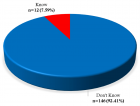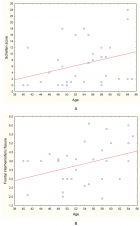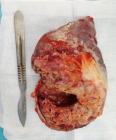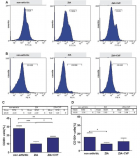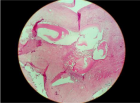Table of Contents
The evaluation of bandage soft contact lenses as a primary treatment for traumatic corneal abrasions
Published on: 25th May, 2020
OCLC Number/Unique Identifier: 8605482786
Background: Corneal abrasions are a common result of eye trauma. Corneal injuries are very common in both the adult and pediatric population and account for a significant proportion of the workload of most emergency departments. Although abrasion heals well with preservative treatment, it still causes pain and job lost. The abrasion result from the scrabble of the corneal epithelium. These injuries cause pain, tearing, lids spasm, light scare, foreign body sensation, decreased visual acuity/blurring, and a gritty feeling. The light, friction & wink was worse the condition. Most abrasion cure within 24-27 hours and seldom proceed to erosion or infection. The study aims to use bandage soft contact lens [BSCL] as a primary treatment for traumatic corneal abrasion [TCA] instead of traditionally use pressure patch [PP].
Patients and methods: The present prospective study has been conducted on 50 patients attending the out-patient department of ophthalmology in an Alyarmouk teaching hospital for six months after taking ethical permission. Before subjecting the patient to the treatment of bandage soft contact lens therapy, a detailed clinical history and thorough local examination have been done. A history indicating the occurrence of recent ocular trauma followed by severe pain, redness, lids spasm, photophobia, and tearing of the involved eye is suggestive of a corneal abrasion. Always we ask about contact lens wear as this can complicate the presence of an abrasion. To confirm the diagnosis of traumatic corneal abrasion we examine the cornea by slit-lamp under cobalt-blue filtered light after the application of tetracaine eye drops & fluorescein strips. The treatment of 50 consecutive patients presenting with traumatic corneal abrasion has been treated with anesthetic eye drop (tetracaine 0.5%) to relieve pain and lids spasm, antibiotic eye drop (ofloxacin 0.3%), therapeutic bandage soft contact lens was applied to provide pain relief and once again act as a splint to promote epithelial healing, then visual acuity was measured by Snellen chart, a cycloplegic eye drop (cyclopentolate 1%) was applied to relieve ciliary spasm & then preservative-free lubricant eye drop were applied lastly. This criterion dramatically relieves most, if not all of the pain the patient may be experiencing (which is a big plus for the patient and earns instantaneous trust), but it also allows the patient to return to work/school or any other daily activities. Patients have been evaluated after 24hours, 72hours and after 1week regarding pain, visual acuity, and complications. Though pressure patch [PP] occasionally advice in abrasion therapy, it does not assist and may prevent recovery. Employ the protective eyewear can preclude the traumatic corneal abrasion.
Results: A total of 50 cases were enrolled in our study during the study period of 6 months. Out of 50 patients, there were 30males and 20 females and the male/female ratio was 3:2. The patient’s age was ranged from 5-35years. The commonest cause of injury was direct minor trauma (80% of cases), with cosmetic & optical contact lenses related problems accounting for 20% of presentations, visual acuity was documented correctly in 90% of adult and pediatric group and difficult to documented in children less than 6-year-old 10%. Traumatic corneal abrasion treated with bandage soft contact lens has an apparent advantage over the traditional pressure patch in terms of reduced pain, speedier healing, and an advantage of faster rehabilitation, facilitation epithelial healing, and proper surface hydration. Evaluation of pain revealed sufficient comfort with this regimen, allowing 45 patients (90%) to go back immediately to their occupations. Moreover, visual function is retained without any complication. Healing of the traumatic corneal abrasion occurred within 1 to 3 days in all patients, with minimal or no pain. The infection did not occur at the time of the follow up. We remove the bandage soft contact lens after 1 week to allow epithelial migration and attachment without the interference of the shearing forces of the upper lid.
Conclusion: The use of bandage soft contact lens as a primary treatment for a traumatic corneal abrasion is a safe and effective method with anesthetic eye drop (tetracaine 0.5%), antibiotic eye drop (ofloxacin 0. 3%), cycloplegic eye drop (cyclopentolate 1%), preservative-free lubricant drop instead of traditionally pressure patch. Bandage soft contact lens causes dramatic improvement from pain, lid spasm, tearing & visual function is retained without any complication, and patients can immediately resume their regular activities.
Can we predict Alzheimer’s Disease through the eye lens?
Published on: 22nd May, 2020
OCLC Number/Unique Identifier: 8601971854
Alzheimer’s Disease (AD) is a common dementia problem of the old population. The two main hallmarks of AD are tau protein and amyloid-beta protein. The relevant investigations on AD suggest that these proteins are also seen in the eye. There are many tests and imaging modalities are used for AD diagnosis. But these techniques are still unable to predict the disease effectively. In this regard, the lens of the eye may help in diagnosing AD. Therefore, a reliable technique for measuring the lens or retina must be selected. In this paper, we focus on the different types of retinal diseases occur in AD patients and the use of the Optical Coherence Tomography (OCT) technique is used for diagnosing AD.
Evaluation of the efficacy of transcorneal electric stimulation therapy in retinitis pigmentosa patients with electrophysiological and structural tests
Published on: 20th May, 2020
OCLC Number/Unique Identifier: 8604562702
A Statement of significance: This study shows that the effect of transcorneal electrical stimulation (TES) therapy as a stimulator device in retinitis pigmentosa (RP)patients with have a significant increase in visual acuity and shortening of p100 latency in pattern visual evoked potential (pVEP) test during 3 months follow up.
Purpose: To assess the safety and efficacy of TES therapy with electrophysiological and structural tests in RP patients.
Methods: Thirty four eyes of 17 RP patients were included in the study. Initial examination included best corrected visual acuity (BCVA) and visual field (VF) test (Humphrey). Central macular thickness (CMT), retinal nerve fiber layer thickness (RNFLT) and choroidal thickness (CT) were measured with using swept-source optical coherence tomography (OCT). The patients were tested by Metrovision brand monpack model visual eletrophysiology device for pVEP and flash electroretinogram (fERG) tests. Patients were seen 12 times during 3 months: initial visit for screening and weekly visits for TES. All tests were repeated 3 times. The results of pre and post TES therapy were compared.
Results: Patients’ baseline BCVA was 0,34 ± 0,22. The increase in the last visit BCVA was significant (p : .001) and it was 0.50 ± 0.29. The difference between CMT, RNLF and CT pre and post TES therapy were not significant (p > .05). The mean latencies of the 120’ pattern p100 waves that patients could see were shortened and statistically significant (p = .04). The peaks amplitudes of the 120’ pattern p100 waves that patients could see were increased; but not statistically significant (p :. 19).
Conclusion: This study shows that the safety of TES as a stimulator device in our patient group and the effect on this group have a significant increase in visual acuity and shortening of p100 latency in pVEP test during 3 months follow up.
Demographic pattern of refractive anomalies in Niger Delta presbyopes - Implications for preventive eye care practice
Published on: 29th January, 2020
OCLC Number/Unique Identifier: 8531090530
Background/Aim: In spite of global initiatives to provide sight for all by the year 2020, many middle-aged to elderly people in the Niger Delta still have significant visual impairment due to uncorrected refractive errors. The aim of this study is to assess the types of refractive anomalies that occur among presbyopic patients in Port Harcourt and determine the demographic pattern of these anomalies based on age and gender characteristics.
Methodology: This is a hospital-based descriptive cross-sectional study in which sixty consecutive adult patients for refraction were seen. Every adult patient that came to get glasses during the study period was included in the study except where ocular or systemic contraindications were present. In addition to visual acuity, all patients had a detailed ocular examination and then refraction. The collected data was subsequently analysed using SPSS version 20.
Results: The mean age of the patients was 54.4 ± 9.4 years with a range of 35 to 80 years. A total of 60 patients were seen, comprising 30 males and 30 females. The commonest refractive error was presbyopia with hyperopic astigmatism and this accounted for 80% of all cases. Hyperopic presbyopia and presbyopia alone were the least common.
Conclusion: There is a high level of cylindrical and spherical errors in Port Harcourt. The full optical correction should always be prescribed to presbyopic patients to fully correct the associated visual impairment and improve the patients’ well-being.

HSPI: We're glad you're here. Please click "create a new Query" if you are a new visitor to our website and need further information from us.
If you are already a member of our network and need to keep track of any developments regarding a question you have already submitted, click "take me to my Query."






